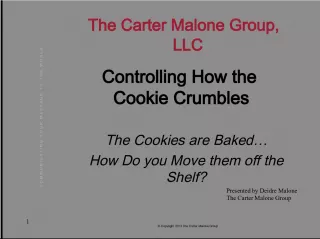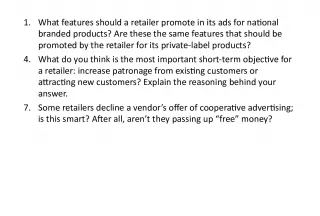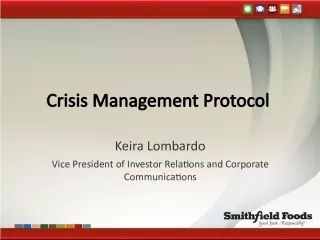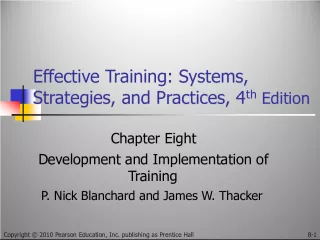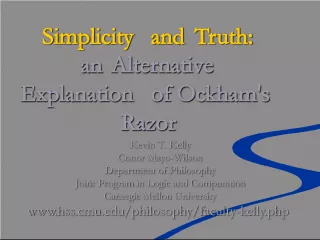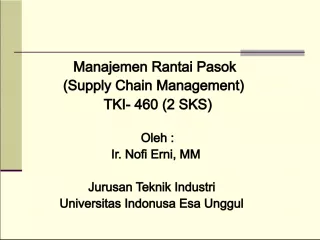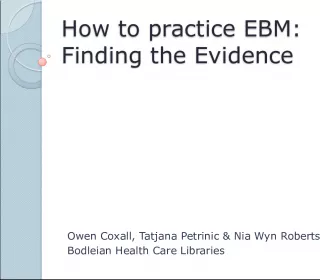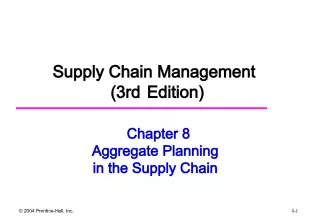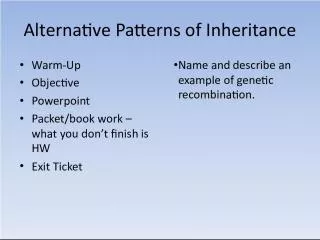Alternative Exit and Restructuring Strategies: Reorganization and Liquidation
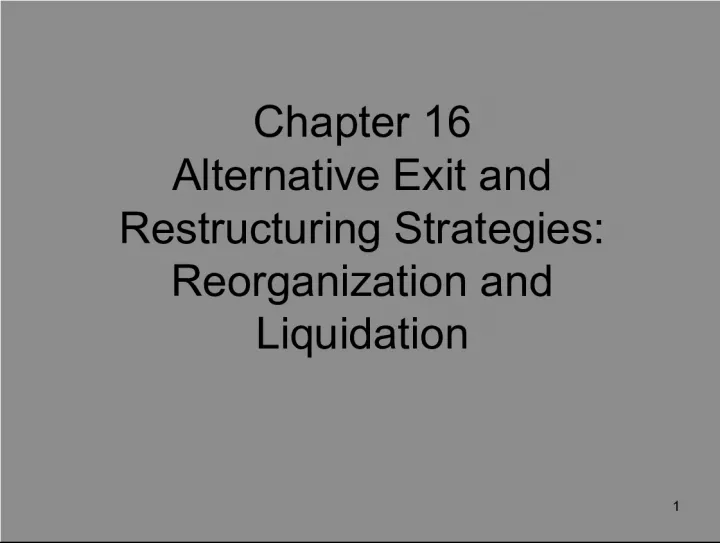

This chapter explores alternative strategies for exiting and restructuring businesses, including reorganization and liquidation. It covers various considerations such as legal, financial, valuation, modeling, taxation, and regulatory aspects. The chapter also discusses motivations for M&A, takeover tactics, financing strategies, cross-border transactions, and other restructuring activities.
- Uploaded on | 8 Views
-
 rosangoc
rosangoc
About Alternative Exit and Restructuring Strategies: Reorganization and Liquidation
PowerPoint presentation about 'Alternative Exit and Restructuring Strategies: Reorganization and Liquidation'. This presentation describes the topic on This chapter explores alternative strategies for exiting and restructuring businesses, including reorganization and liquidation. It covers various considerations such as legal, financial, valuation, modeling, taxation, and regulatory aspects. The chapter also discusses motivations for M&A, takeover tactics, financing strategies, cross-border transactions, and other restructuring activities.. The key topics included in this slideshow are alternative exit strategies, restructuring, reorganization, liquidation, M&A, valuation, modeling, taxation, regulatory considerations, takeover tactics,. Download this presentation absolutely free.
Presentation Transcript
1. Chapter 16 Alternative Exit and Restructuring Strategies: Reorganization and Liquidation 1
2. Course Layout: M&A & Other Restructuring Activities Part IV: Deal Structuring & Financing Part II: M&A Process Part I: M&A Environment Payment & Legal Considerations Public Company Valuation Financial Modeling Techniques M&A Integration Business & Acquisition Plans Search through Closing Activities Part V: Alternative Strategies Accounting & Tax Considerations Business Alliances Divestitures, Spin-Offs & Carve-Outs Bankruptcy & Liquidation Regulatory Considerations Motivations for M&A Part III: M&A Valuation & Modeling Takeover Tactics and Defenses Financing Strategies Private Company Valuation Cross-Border Transactions 2
3. Learning Objectives Primary Learning Objective: To provide students with an understanding of alternative strategies for failing businesses Secondary Learning Objectives: To provide students with an understanding of Criteria for choosing strategy for failing firms Process for filing for bankruptcy, voluntary and involuntary settlements inside and outside of court, and voluntary and involuntary liquidation 3
4. Rule of Law and Corporate Asset Allocation The smooth functioning of capital markets requires rapid and fair resolution of disputes involving the legal rights of borrowers and lenders Studies show that borrowing costs are lower and access to credit easier in countries which enforce credit rights. Total cost of financial distress (i.e., inability to meet financial obligations) includes the following: --Employee layoffs --Firm under-investment --Eroding community tax base and blight --Customer dissatisfaction with declining product quality and increasing delivery times --Delayed payments to suppliers (including lenders) --Higher borrowing costs --Declining shareholder value Bankruptcy plays key role in minimizing these costs by providing a process for resolving these issues in a timely manner. 4
5. Bankruptcy Applicable to failing firms A firm is technically insolvent if it is unable to pay its liabilities as they come due A firm is legally insolvent if a firms liabilities exceed the fair market value of its assets Designed to protect failing firms from lawsuits by its creditors until decision made to shut-down or to continue operating the firm A firm not considered bankrupt until it or its creditors petition the federal bankruptcy court 5
6. Signs and Risks of Distress Ratings downgrades Near scheduled expiration of credit lines Complex capital structures Pending regulatory investigations Auditor discord or qualified opinion Change of lender representatives Debt reduction programs Cost reduction initiatives layoffs, concessions Unexpected changes in management Ball and Kane, A Practical Guide to Distress M&A , The M&A Lawyer 6
7. Examples Los Angeles Dodgers Prince Sports Kodak Hostess MF Global Lehman General Motors Delphi formerly GM supplier. 7
8. Voluntary Reorganization Outside of Bankruptcy Court Generally offers best chance for owners to recover a portion of their investment Usually, initiated by debtor firm by requesting relief from creditors Such relief often consists of the following: An extension : Creditors agree to lengthen period during which debtor firm can repay its debt. May also include a temporary suspension of both interest and principal repayments A composition : Creditors agree to settle for less than the full amount they are owed Debt for equity swap : Creditors surrender a portion of their claims in exchange for an ownership position in the firm 8
9. Voluntary Liquidation Outside of Bankruptcy Court If creditors conclude insolvent firms situation cannot be reorganized, liquidation may be only course of action If insolvent firm is willing to accept liquidation and all creditors agree , legal proceedings not necessary Creditors normally prefer liquidations to avoid lengthy and costly litigation Significant issue: liquidation vs. going concern 9
10. Reorganization and Liquidation in Bankruptcy In absence of out-of-court voluntary settlement, debtor firm may seek protection from creditors by petitioning the bankruptcy court or be forced into bankruptcy by its creditors Bankruptcy allows creditor firm to stop all principal and interest payments and prevents secured creditors from taking possession of their collateral Stay U.S. Bankruptcy Code: Chapter 11 deals with reorganization and provides for the debtor to remain in possession, unless court rules otherwise Chapter 7 deals with liquidation and defines priority in which creditors will be paid Chapter 15 addresses insolvency issues involving assets, lenders, and other parties in various countries 10
11. Chart 16-1. U.S. Chapter 11 Filings By Fiscal Year (Public and Private Companies) Source: Administrative Office of the United States Courts 11
12. Chapter 11 Filings 12
13. Chapter 11 Statistics Public record but difficult to identify Approximately 1% of total filings September 2011 and September 2010 Filings 1,596,355 1,467,732 Terminations 1,496,732 1,461,896 Pending 1,659,086 1,664,393 Conclusion: Increase 2.75 X 2008 13
14. Procedures for Reorganizing in Bankruptcy Filing with the Bankruptcy Court Appointment of Debtor in Possession or Court Trustee Develop and Present Reorganization Plan Acceptance of Reorganization Plan by All Parties Payment of Court Approved Expenses 14
15. Bankruptcy Abuse Prevention and Consumer Protection Act of 2005 (BAPCPA) Pre-BAPCPA: Debtor in possession (DIP) had exclusive right for first 120 days to file a reorganization plan before creditors could submit their own plan Court could at its discretion provide extensions Leases could be extended indefinitely as long as payments made Post-BAPCPA: Stop the foot dragging Caps DIP exclusivity period at 18 months with an additional 2 months to win creditors acceptance of reorganization plan, effectively giving DIP a maximum of 20 months before creditors can submit their plan Good cause lease extensions limited to 90 days Payments to management employees cannot be more than 10 times amount paid to non-management employees Chapter 11 Success ? Warren & Westbrook, The Success of Chapter 11: A Challenge to The Critics, Michigan Law Review Vol. 107:603 15
16. Liquidation in Bankruptcy If the bankruptcy court determines reorganization not feasible , failing firm may be forced to liquidate Priority in which claims are paid (per Chapter 7 of U.S. Bankruptcy Code) Past due property taxes Secured creditors up to proceeds of the sale of pledged assets Legal fees Expenses incurred after involuntary case begun but before trustee appointed Wages not to exceed $2000 per worker Unpaid employee benefit plan contributions up to $2000 Unsecured customer deposits of $900 or less Income taxes owed federal, state, or local governments Under-funded pension liabilities up to 30% of the firms book value Unsecured creditors Preferred shareholders, up to par value of their stock Common shareholders, paid out of remaining funds 16
17. Prepackaged Bankruptcies Debtor negotiates reorganization plan with major creditors well in advance of filing for Chapter 11 Subsequent Chapter 11 reorganization averages a few months as court only has to approve the plan Minority creditors may be required to accept the plan by the court Cram Down Debtor may lose NOLs if out of court settlement reached in which creditors exchange their debt for equity and original shareholders own less than 50 percent of firm. In bankruptcy, debtor may claim NOLs . Unless GM Beechcraft 5/3/12 swap debt for equity Fitzgerald & Beaudette , Hawker Beechcraft Files for Chapter 11 , WSJ, May 3, 2012 17
18. Choosing Appropriate Restructuring Strategy: Failing Firms Choice heavily influenced by the following: Going concern value of debtor firm Sale value of debtor firm Liquidation value of debtor firm Implications: If sale value > going concern or liquidation value, sell firm If going concern value > sale or liquidation value, reach out of court settlement with creditors or seek bankruptcy protection under Chapter 11 If liquidation value > sale or going concern value, reach out of court settlement with creditors and liquidate or liquidate under Chapter 7 18
19. Examples 2011-2012 Borders February 2011 Assets $1.28B; Liabilities $1.2b GE Capital provided DIP financing $550M Sales down double digit each quarter from 2008 6,100 staff, 508 stores including Waldenbooks Liquidation sale $700M in July 19
20. A123 Bankruptcy October 2012 Bankruptcy Presidential election issue -$249M/$120M Awaiting court approval 12/11/12 2PM Other suitors Johnson Controls & NEC Also CFIUS approval Treasury may stop Original deal Wanxiang 80% -$450M Now gets 100% (less US govt. deal) $260M Military/industry businesses too similar 20
21. Examples 2011-2013 MF Global November 2011 8 th largest Firm began 1783 by James Man 12/8/11 Corzine Sgt. Schultz defense. Ongoing hearings today as CH 11 proceeds Former FBI head Louis Freeh, Trustee October 30 material shortfall; $7B in August October 31 accounts frozen; petition filed Invested $6B in European sovereign bonds Mixed customer and firm assets; loss > $1B Cannot be primary dealer Assets: $41B; liabilities $40B 21
22. Examples 2013 Atari cleared Ch 11. No game buyers Building 19 Gallup NM Catholic Diocese City of Detroit (Chapter 9) Blockbuster Cengage PUBLISHER Bebo Former AOL subsidiary 22
23. Discussion Questions 1. Why should corporate bankruptcy be considered a potential business strategy? 2. Under what circumstances is the bankruptcy court likely to decide that a failing firm should be liquidated? 3. What are the primary options available to a failing firm? What criteria should be used to select the best option? Be specific. 4. When is a prepackaged bankruptcy an appropriate option? 23
24. Things to Remember Bankruptcy process supports smooth functioning of capital markets by protecting creditor and debtor rights Generally offers best chance for owners to recover a portion of their investment Bankruptcy allows creditor firm to stop all principal and interest payments and prevents secured creditors from taking possession of their collateral A failing firms options are to merge with another firm, reach an out-of-court voluntary settlement with creditors, or file for Chapter 11 bankruptcy protection 24








